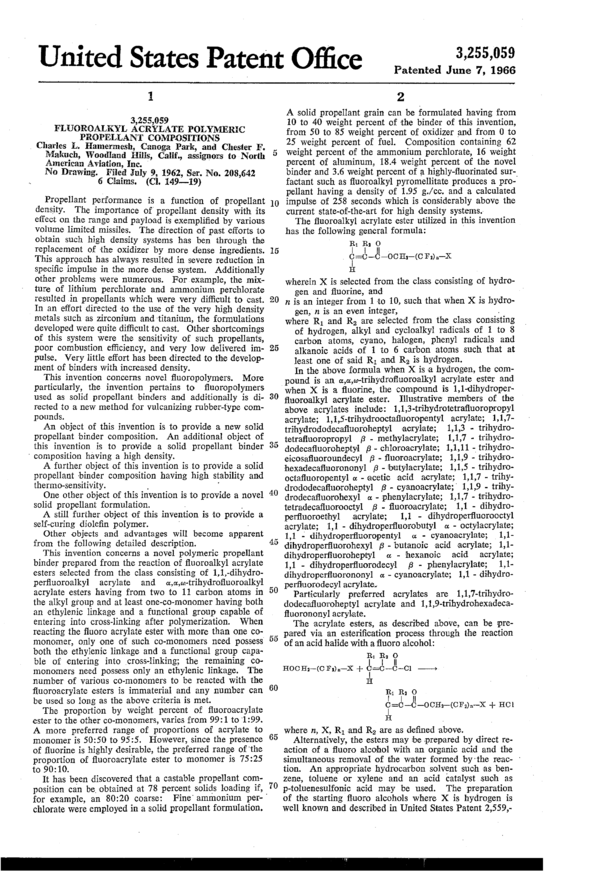�������United States Patent Office
3,255,059
Patented June 7, 1966
1
3,255,059
FLUOROALKYL ACRYLATE POLYMERIC
PROPELLANT COMPOSITIONS
. Charles L. Hamermesh, .Canoga Park, and Chester F.
Makuch, Woodland Hills, Calif., assignors to North
American Aviation, Inc. ’
No Drawing. Filed July 9, 1962, Ser. No. 208,642
6 Claims. (Cl. 149-19)
Propellant performance is a function of propellant
dens_1ty. The importance of propellant density with its
effect on the range and payload is exemplified by various
volume limited missiles. The direction of past efforts to
obtain such high density systems has ben through the
replacement of -the oxidizer by more dense ingredients.
ThlS' approach has always resulted in severe reduction in
specific impulse in the more dense system. Additionally
other problems were numerous. For example, the mix-
ture of lithium perchlorate and ammonium perchlorate
resulted .in propellants which were very diflicult to cast.
In an effort directed -to the use of the very high density
metals such as zirconium andtitanium, the formulations
developed were quite diflicult to cast. Other shortcomings
o_f this system were the sensitivity of such propellants,
poor combustion efiiciency, and very low delivered im-
pulse. Very little effort has been directed to the develop-
ment of binders with increased density.
This invention concerns novel fluoropolymers. More
particularly, the invention pertains to fluoropolymers
used as solid propellant binders and additionally is di-
rected to a new method for vulcanizing rubber-type com-
pounds.
An object of this invention is to provide a new solid
propellant ‘binder composition. An additional object of
this invention is to provide a solid propellant binder
' composition having a high density.
A further object of this invention is to provide a solid
propellant -binder composition having high stability and
thermo-sensitivity. _ '
One other object of this invention is to provide a novel
solid propellant formulation. ,
A still further object of this invention is -to provide a
self-curing diolefin polymer. ' .
Other objects and advantages will become apparent
from the following detailed description.
This invention concerns a novel polymeric propellant
binder prepared from the reaction of fluoroalkyl acrylate
esters selected from the class consisting of 1,l,-dihydro-
perfiuoroalkyl acrylate and oa,a,w.-trihydrofluoroalkyl
acrylate esters having from two to 11 carbon atoms in
the alkyl group and at least one-co-monomer having both
an ethylenic linkage and a functional group capable of
entering into cross-linking after polymerization. When
reacting the fluoro acrylate ester with more than one co-
monomer, only one of such co-monomers need possess
both the ethylenic linkage and a functional group capa-
ble of entering into _cross-linking; the remaining co-
monomers need possess only an ethylenic linkage. The
number of various co-monomers to be reacted with the
fluoroacrylate esters is immaterial and any number can
be used so long as the above criteria is met.
The proportion by weight percent of fluoroacrylate
ester to the other co-monomers, varies from 99:1 to 1:99.
A more preferred range of proportions of acrylate to
monomer is 50:50 to 95:5. However, since the presence
of fluorine is highly desirable, the preferred range of ‘the
proportion of fluoroacrylate ester to monomer is 75:25
to 90: 10.
It has been discovered that a castable propellant com-
position can be_ ‘obtained at 78 percent solids loading if,
for example, an 80:20 coarse:
chlorate were employed in a solid propellant formulation.
Fine‘ ammonium per- '
5
10
15
20
25
30
40
45
50
55
60
65
70
2
A solid propellant grain can be formulated having from
10 to 40 weight percent of the binder of this invention,
from 50 to 85 weight percent of oxidizer and from 0 to
25 weight percent of fuel. Composition containing 62
weight percent of the ammonium perchlorate, 16 weight
percent of aluminum, 18.4 weight percent of the novel
binder and 3.6 weight percent of a highly-fluorinated sur-_
factant such as fluoroalkyl pyromellitate produces a pro-
pellant having a density of 1.95 g./cc. and a calculated
impulse -of 258 seconds which is considerably above the
current state-of-the-art for high density systems.-
The fluoroalkyl acrylate ester utilized in this invention
has the following general formula:
R1R2O

